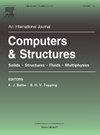Large displacement analysis of masonry structures coupling enhanced virtual elements and damage-friction interfaces
IF 4.4
2区 工程技术
Q1 COMPUTER SCIENCE, INTERDISCIPLINARY APPLICATIONS
引用次数: 0
Abstract
Enhanced virtual elements are coupled with cohesive interfaces to create a numerical tool tailored for large displacement analysis of block structures. The model is particularly suitable for masonry composed of stones or bricks connected with or without mortar. Each masonry block is modeled with a single elastic virtual element (VE), based on a divergence-free polynomial approximation of the stress field within the element, and the corotational formulation recently developed by the authors. These stabilization-free VEs are coupled, for the first time, with damaging-frictional interfaces representing the layers interconnecting the blocks, which are innovatively extended to the large displacement framework. Furthermore, in the context of virtual elements, a novel method is presented to accurately evaluate nodal forces equivalent to body loads when internal degrees of freedom are not available.
Some numerical applications are performed to investigate the capability of the proposed formulation to reproduce the response of single masonry elements and more complex structural schemes. The analyses prove that the model reproduces well the main nonlinear mechanisms due to the presence of large displacements and material degradation caused by cracking and friction. Finally, the model potential to handle irregular stone walls is proved through numerical–experimental comparison.
增强虚拟单元与损伤-摩擦界面耦合的砌体结构大位移分析
增强的虚拟元素与内聚界面相结合,创建了一个适合块状结构大位移分析的数值工具。该模型特别适用于用砂浆或不用砂浆连接的石头或砖组成的砌体。每个砌块都用单个弹性虚拟单元(VE)建模,该单元基于单元内应力场的无散度多项式近似和作者最近开发的旋转公式。这些无稳定的ve首次与代表连接块的层的破坏摩擦界面耦合在一起,并创新地扩展到大位移框架。此外,在虚拟单元的背景下,提出了一种在没有内部自由度的情况下准确计算等效于体荷载的节点力的新方法。一些数值应用研究了所提出的公式的能力,以重现单一砌体单元和更复杂的结构方案的响应。分析表明,该模型能够较好地再现主要的非线性机制,因为存在较大的位移和由裂纹和摩擦引起的材料退化。最后,通过数值-实验对比验证了模型处理不规则石墙的潜力。
本文章由计算机程序翻译,如有差异,请以英文原文为准。
求助全文
约1分钟内获得全文
求助全文
来源期刊

Computers & Structures
工程技术-工程:土木
CiteScore
8.80
自引率
6.40%
发文量
122
审稿时长
33 days
期刊介绍:
Computers & Structures publishes advances in the development and use of computational methods for the solution of problems in engineering and the sciences. The range of appropriate contributions is wide, and includes papers on establishing appropriate mathematical models and their numerical solution in all areas of mechanics. The journal also includes articles that present a substantial review of a field in the topics of the journal.
 求助内容:
求助内容: 应助结果提醒方式:
应助结果提醒方式:


